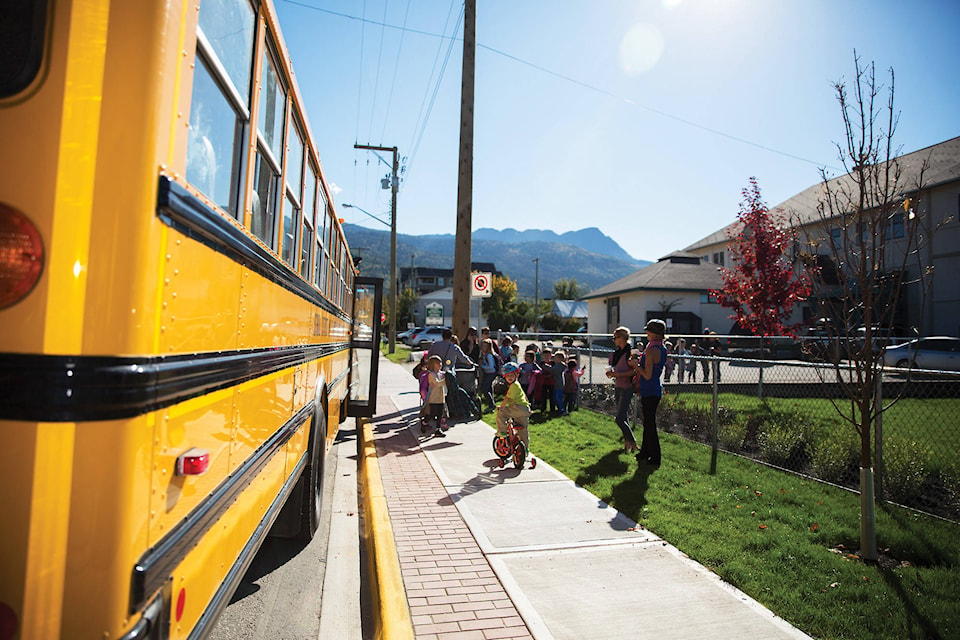More students will be walking to school in September should recommended changes to the North Okanagan-Shuswap School District’s transportation policy be implemented.
A report to the school district is recommending the elimination of middle school “courtesy riders.” These are students who live within the school district’s mandated 3.5 kilometre walk limit from their catchment school, but ride the school bus either to or from school on a regular basis.
In past, courtesy riders have been allowed if there is room on buses to accommodate them.
In 2017, the school district reduced its walk limits from 4.8 kilometres to 3.5 km for all grades, making more students eligible for the bus than before.
Related link: New and improved bus service for students
Related link: Funding boosts bus service
While kindergarten to Grade 5 courtesy riders, especially on the downtown to Hillcrest and South Broadview routes, are still being recommended, the report suggests the elimination of all courtesy riders for Grade 6 to 8.
The report also recommends the school district no longer support transportation of students to and from before and after school care.
“These care providers should provide their own transportation for their customers,” states the report.
Related link: Parents fight bus elimination
Some of these recommendations are very worrying to parents like Nikki Wilson, who believes not enough parents know about the implications of this report. In her case, her daughter, who will be attended SMS in September, will now have a 40 to 45 minute walk to school that includes crossing the Trans-Canada Highway and covering some challenging topography. She notes that in Vernon the walk limit is 2.4 kilometres.
“It’s not all walking on flat streets with nice sidewalks,” she says. “Salmon Arm is very hilly, with many streets without sidewalks or the sidewalks are not plowed right away in winter. We are talking about 10-year-old kids. I would like to see some of the transportation people walk that every day and then decide if there’s a need to let these kids on the bus.”
Wilson points out that the changes also increase pressures on working parents, who might not be able to leave their jobs around the 2:15 dismissal times to take kids home or to child-care programs. She also points out that Salmon Arm has few other public transportation options.
“A lot of people don’t have flexible jobs, so what do they do if their kids are not longer allowed to ride the bus? How do they work and make sure their kids are safe and cared for?”
At a recent public meeting on the subject, official trustee Mike McKay explained the transportation review was necessary as the number of courtesy riders on district buses was reaching a “critical” point on some routes where demand is exceeding capacity. “We can’t avoid the problem.”
The report states various problems with accommodation of courtesy riders including: longer ride times for eligible riders, longer wait times for students at school, earlier pick up times from home, additional resources for early supervision at schools, bus overloads, late drop-offs at school and numerous complaints from parents and schools.
“The district needs to decide on consistent practices around courtesy riders and the transportation department needs to be able to make and uphold the decisions to ensure that transportation services are fair and equitable for all riders across the district,” states the report.
“This is not a pain-free situation,” commented McKay. “Unfortunately we will not be able to respond positively to all the requests for courtesy riders. We will continue to service courtesy riders on all routes where we have capacity.”
McKay notes capacity, the length of ride (at the extreme, on one route, courtesy riders have added 45 minutes to the run), and having predictable space for eligible riders are at the core of the need for change.
Related link: School district denies bus appeal
Wilson says she understands the situation the school district is in when it comes to capacity, but thinks something could be done, possibly charging a fee to support the courtesy bus riders.
“I would pay a fee. I would love to pay a fee to know (my daughter) would be safe.”
Currently the school district provides daily school bus service for approximately 3,000 students. It has 46 buses serving 34 routes which travel approximately 6,300 km each day.
The transportation department will now fine tuning its the recommendations in the review, which will be brought forward to the May 22 school board meeting for possible approval.
@SalmonArm
newsroom@saobserver.net
Like us on Facebook and follow us on Twitter
